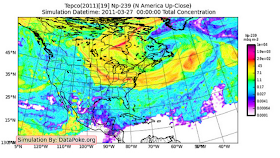The FLEXPART Neptunium 239 and Plutonium 239 fallout models shown have some SIGNIFICANT weaknesses. None-the-less, given our own detections indicating Saint Louis Neptunium 239 fallout they have some relative value. You may find and run the models here
Particle Modeling, Observation, and Measuring.
Hat tip to Annette2 on http://www.enviroreporter.com/2011/09/radiation-conversation/


Re: FLEXPART Model Showing Neptunium 239 and Plutonium 239
ReplyDeleteCan you please say more about the weaknesses in these plutonium/neptunium models? I was very concerned to see them, and would be interested in hearing a knowledgeable person's analysis regarding their significance/accuracy.
Nemo,
ReplyDeleteFrom memory, the primary weakness that comes to mind is they used Cesium Vaporization rates to model Plutonium. Basically they took their best SWAG, given they did not have the right data available to perform the analysis. Our take on the map is that it was useful in showing the risk areas for fallout deposition, but not necessarily for identifying the type of fallout occurring.
But given that there is now data showing that Uranium formed "bucky balls" (as a result of the salt water cooling) pretty much every dispersion simulation is likely wrong and too conservative. see out 1/27/12 blogpost
Thank you for this response. I was quite concerned to see that model because I live in northern Indiana, and the model shows a very high concentration of Plutonium (and Neptunium) crossing over that area. Based on what you said about the model using cesium vaporization rates instead of plutonium-based info, do you think the amount of plutonium/neptunium that might have floated through the area is likely to be higher or lower than what the model shows? (I thought everyone at the time said Plutonium was too heavy to travel so far, but I have since heard it was detected even in Europe.) Do you know of any actual data regarding Plutonium beyond the West Coast in March/April? I know you said Neptunium might have been detected in rain in St. Louis even more recently, but I'm mainly trying to gauge what might have been floating in Indiana's air last spring when the initial plume(s) went by.
ReplyDeleteBy the way, thank you for your informed analysis. Your recent remarks about the solar flares where particularly helpful--Indiana and Ohio had some triple digit spikes in beta-counts over the last couple of days (seeming to coincide with the solar flare's arrival), so I'm thinking your spallation theory might be the explanation for the spikes.
Nemo, The best one can say about that map is that it gives an indication where the fallout was most likely for the expected weather conditions at the time. It looks like it is strongly influenced by the Jet Stream.
ReplyDeleteWe had one, maybe two fallout events that were indicative of Neptunium. We are working on getting some better data for the Saint Louis area, but it is expensive and time consuming. The people who said Plutonium was to heavy to fly were either clueless or deceptive.
To figure out what your local risk was the best bet would be to look at Jet Stream and Rainfall data for that time period; with greater likelihood of fallout coming from the thunder storms
The impact of the Solar Events is difficult to predict or confirm, there are just too many variables. For the most part, we would not expect such spallation events to be immediately noticeable because the fallout would have to work its way down from the upper atmosphere. One thing we do expect is that Canada and the USA got the worst of it because we were on the sunlit side of the impact.
Thanks for this additional explanation. If you don’t mind, I have one last follow up question. One of your videos mentions that fallout in rain is typically heavier toward the end of a rainstorm (if I understood what you said correctly). But what about after the rainfall has ended? Does the fallout tend to hang low in the air (assuming there is still moisture in the air), or does the rain “wash out” the stuff from the air so that the amounts floating in air after a rainstorm has ended would be less than before?
DeleteWe don't run 100% continuous airborne monitoring, but we will likely change that soon because of what has happened in other locations. In the data we have taken, it is often possible to see when the storms are moving through. An individual in southern Illinois was actually able to show a spike in airborne detections AND rain swipe detections when the Jet Stream moved over his location. We also had a airborne detections hit several times above background when we drove through a cloud burst, just west of Atlanta, Ga.
ReplyDeleteWere we have noticed airborne radiation levels remaining high are during and after snow showers. In those instances background radiation went up 2x background and persisted long enough to be readily and easily recognizable as significantly different.